Abandoned by conservationists and the global community, Virachey National Park in Cambodia remains a wildernesses of surprises. An interview with Greg McCann.
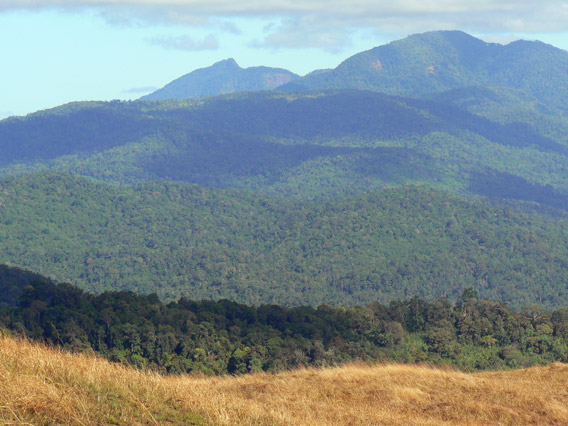
Haling-Halang and the barrier mountains separating Cambodia and Laos as seen from the Veal Thom grasslands, a place few outsiders have ever seen. Could tigers, Javan rhinos, or saola live in these mountains? No one knows. Photo by: Greg McCann.
Abandoned by NGOs and the World Bank, carved out for rubber plantations and mining by the Cambodian government, spiraling into a chaos of poaching and illegal logging, and full of endangered species and never-explored places, Virachey National Park may be the world’s greatest park that has been written off by the international community. But a new book by explorer and PhD student, Greg McCann, hopes to change that. Entitled Called Away by a Mountain Spirit: Journey to the Green Corridor, the book highlights expeditions by McCann into parts of Virachey that have rarely been seen by outsiders and have never been explored scientifically, including rare grasslands that once housed herds of Asian elephants, guar, and Sambar deer, before poachers drove them into hiding, and faraway mountains with rumors of tigers and mainland Javan rhinos.
“It is the most jaw-dropping place that I have ever seen in my life, and I have traveled in Nepal, Alaska, Indonesia, and elsewhere,” McCann told monagaby.com in an interview. “After two and a half days of tough jungle trekking, you emerge from the canopy into an upland world of sunlight and burnt yellow savanna hills set against a huge chain of dark green mountain […] The grasslands seem inexplicable—a secret world of golden light and open vistas carved out of the middle of the jungle, an immense area of rolling amber hills that would require two days to walk the entire circumference.”
These are the Veal Thom grasslands, which have rarely been seen by outsiders, yet McCann has traveled there three times. A Rapid Assessment Survey (RAP) by Conservation International (CI) recorded rich biodiversity in the park in 2007, spending much of their time in the Veal Thom grasslands. Over 15 days, they found 30 species of ants, 19 katydids, 37 fish, 35 reptiles, 26 amphibians, and 15 mammals, including a surprising number of sightings of the Asian wild dog known as dholes (Cuon alpinus), a predator that is listed as Endangered by the IUCN Red List.
Beyond the “inexplicable” grasslands of Veal Thom lie the unexplored mountains and another, even more remote, grasslands, the Yak Yeuk.
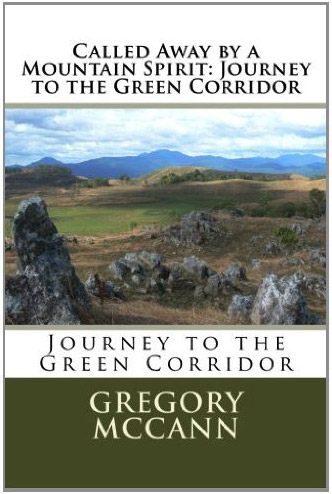 |
“No photos exist of Yak Yeuk anywhere on the net—a rarity today (you can’t even see it from Google Earth, as cloud cover is blocking the view),” McCann says, noting that this region “has never been explored by scientists or visited by tourists. If not for World Bank Sponsorship between 2004-2008, rangers would never have visited the place either.”
Rangers had to cut their way through forest for five days to reach these grasslands, but when they did McCaan says they were rewarded with magnificent sites: “gaur were spotted in the open, and gibbons and douc langurs watched the rangers with curiosity from trees at the edge of the grasslands before running off.”
Stories from locals have convinced McCann that a small population of Indochinese tigers (Panthera tigris corbetti) survive in the mountains, and that these untouched places may even harbor populations of the saola (Pseudoryx nghetinhensis), a Critically Endangered mammal that was only discovered in the 1990s. To date the saola has never been confirmed in Cambodia, but only in neighboring Laos and Vietnam.
“[Virachey National Park] has got to be as important as anywhere on earth,” McCann says noting that on his treks he has seen a number of endangered species and signs of many more others. “If a large core area of the park can be preserved […] then suitable and extensive habitat will remain for the species.”
The park was dubbed by McCann’s guides as Indo-china’s “last forest.” In fact, according to Conservation International (CI), the forest of the Indo-Burma hotspot (comprising Cambodia, Vietnam, Laos, Thailand, Myanmar, and parts of India) are the world most threatened hotspot. Only 5 percent of the historical forests remain.
So, how did a place of such global importance and unexplored wonders come to be abandoned by conservation groups and the international community alike, not to mention the Cambodian government?
According to McCannn it started in 2008 when the Cambodian government announced it would allow Indochine Limited to explore 90 percent of Virachey National Park for mining of gold, bauxite (for aluminum), and other metals. A shellshocked World Bank, which had invested million in the park, left.
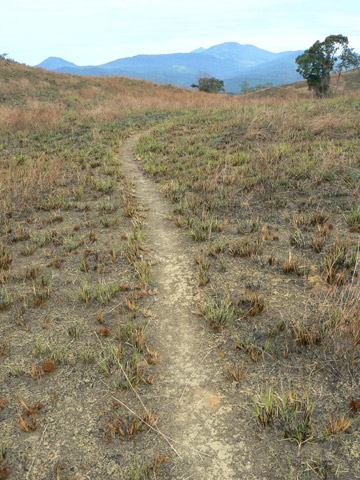 Trail across Veal Thom that appears to lead directly to Haling-Halanga Mountain. Photo by: Greg McCann. |
“When the World Bank pulled out, the park went into a free fall, and it is plunging into virtual anarchy today, with loggers and hunters seen by the dozen in and around Veal Thom and everywhere east to Vietnam,” McCann says.
Next came rubber plantation concessions inside the park and proposals for large hydroelectric projects.
“Quite a bit of the park—possibly as much as one third of it (exact figures are impossible to come by as the government is secretive) has already been sold off to rubber developers,” McCann notes, adding that, “Conservation groups look at those maps of Virachey—the ones that break the park up into different zones for different uses—mining, rubber, and other development projects including dams—and they shudder.”
Between the threats of mining and rubber plantations, along with illegal hunting and logging, conservation groups have simply stayed away. However, McCann insists not all is lost. To date no mining has actually occurred and, according to McCann, it looks like the company has not yet found any worthwhile deposits. He says that while the rubber plantations are regrettable, “there is still a huge area of the park (its total area is 3,325 square kilometers) that can be conserved as a major core zone.”
“If WWF or WCS or Panthera or somebody went in there, and produced evidence of rare wildlife with camera traps and tried to work in a REDD program there along with NGO commitment, the government would, I think, at least temporarily hold off on other development plans,” McCann says.
Reinvigorating conservation in Virachey would also have positive impacts for the entire region, according to McCann.
“Laos and Cambodia might be persuaded to set up an “international peace park” between Virachey and Nam Kong PPA, preserving the major watershed of the area along with wildlife and the traditional hunting grounds for indigenous people, and ecotourism possibilities are endless.”
In a May 2012 interview Greg McCann discuss his new book, his treks deep into Virachey’s unexplored wildernesses and his passion for protecting them, and his research on the Animism beliefs of indigenous highland people n the park.
INTERVIEW WITH GREG McCANN
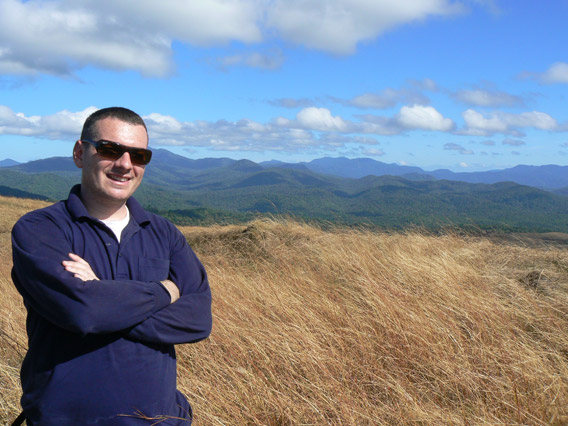
Greg McCann in the Thom Veal grasslands. Photo by: Greg McCann.
Mongabay: What is your background?
Greg McCann: I am PhD student at Tamkang University in Taipei, Taiwan, where I am studying Ecocriticism, a form of scholarship that looks for ecological undertones or “green readings” in literary texts, the discovery of which might be used for environmental advocacy. I am interested in bioregionalism, or, ecosystem-based living. The idea behind bioregionalism is that a society should be able to meet all of its basic needs within a given watershed or biological zone. In fact, according to scholars such as Kirkpatrick Sale and Jim Dodge, this is the way that humanity has lived for most of its existence. When a community or society has lived in an area for a long time, they know the carrying capacity of the land, they know how to use its resources without causing ecological overshoot or collapse, and they can, usually, make better political decisions about how life should be governed there, as opposed to top-down orders being given by a remote central government that might actually have little knowledge of what a community really needs or how it functions. Literary examples of bioregionalism can be found in Aldous Huxley’s Island and Linda Hogan’s Solar Storms.
VIRACHEY NATIONAL PARK
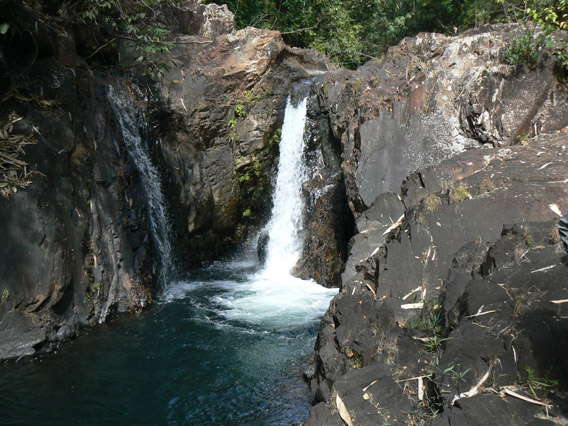
Waterfall on the Tak Mak River in Virachey National Park. Photo by: Greg McCann.
Mongabay: Your new book chronicles your travels to remote and unexplored region in northeast Cambodia. What drove you to explore the largely unknown Virachey National Park?
Greg McCann: At first, it was the geography—a huge, mountainous national park up in a wild borderland region of Ratanakiri province (and I loved that name too, Ratanakiri, which translates to “the mountain of precious stones”). This was supposed to be a land of mountain spirits and tree fairies, a forgotten branch of the Annamite Chain wedged between Laos and Vietnam. Then I picked up a copy of Lonely Planet and read about the 7-day trek to a large grasslands (Veal Thom) deep within Virachey. This park is bordered by rugged jungles and protected areas in both Laos and Vietnam, and taken together, Virachey and the areas across the borders comprise an immense wilderness on this mysterious arm of the southern Annamite Range. And the icing on the cake was this: Lonely Planet suggested that the park was so huge and relatively unexplored that Javan rhinos were rumored to persist deep within the interior of the jungle.
Furthermore, I wanted to cross-reference bioregionalism with animism; I figured that what indigenous societies have been doing for millennia was probably very closely linked with this environmental philosophy, and I had read that in northeastern Cambodia—particularly Ratanakiri and Mondulkiri provinces the indigenous or “highlander” people who lived there were still mostly animists. Due to decades of warfare and instability, Christian missionaries had stayed away, and the highlanders had retained their traditional beliefs. I was sold.
Mongabay: What is the global importance of this park?
Greg McCann: It has got to be as important as anywhere on earth. Between my three trips spanning 2010-2012 we found signs of: clouded leopard, leopard, Asian golden cat, jungle cat, sun bear, Asiatic black bear, gaur, small-clawed otter, pangolin, civet cats, wild boar, and stump-tailed macaques. We saw with our own eyes: gibbons, douc langurs, Sambar deer, barking deer, Great hornbills, Oriental pied hornbills, water dragons, and a poisonous snake which my guide did not know the name of. If a large core area of the park can be preserved (I say “if” because huge areas along the Vietnamese border have already been sold off to rubber developers) then suitable and extensive habitat will remain for the species mentioned above (several of which are endangered), and also for the Indochinese Tiger, four to five of which are thought to remain in the extremely remote and never-before surveyed mountainous borderland with Laos and Cambodia. One of my guides and several other rangers heard two tigers roaring one evening in an area near the Vietnamese border, an area now conceded to rubber development. The guides refer to Virachey as Indochina’s “last forest.”
THE GRASSLANDS
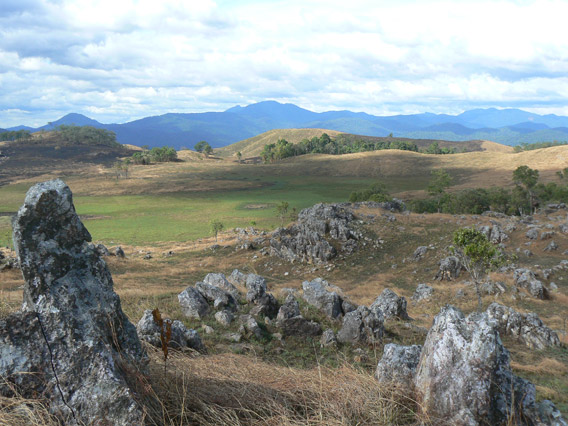
The Veal Thom grasslands. Photo by: Greg McCann.
Mongabay: Cambodia is thought of as a nation of wild jungles. Will you tell us about the Veal Thom grasslands?
Greg McCann: It is the most jaw-dropping place that I have ever seen in my life, and I have traveled in Nepal, Alaska, Indonesia, and elsewhere. After two and a half days of tough jungle trekking, you emerge from the canopy into an upland world of sunlight and burnt yellow savanna hills set against a huge chain of dark green mountains: these are the mountains that divide Laos and Cambodia, an arbitrary borderline selected by the French in 1904. The grasslands seem inexplicable—a secret world of golden light and open vistas carved out of the middle of the jungle, an immense area of rolling amber hills that would require two days to walk the entire circumference. According to the Brao people who live along the Sesan River south of the park, Veal Thom (which means ‘wilderness grasslands’) was formed by a family of giants who used the area as farmland. One day there was a family dispute, and several of them stalked off in anger and established the Yak Yeuk Grasslands, which is about 15km east of Veal Thom.
My guides say that 30 years ago the hills of Veal Thom were black with elephants, gaur and Sambar deer, but today only the Sambar deer remain (of those three); the remaining elephants have fled into the barrier mountains and gaur hide out in the forests north and south of Veal Thom, but rarely come out into the open anymore. Because of the Khmer Rouge, they say, everyone in Ratanakiri had a gun, and they went up into the grasslands and wiped out the vast herds.
Mongabay: What was it like to visit a part of the world that has been rarely explored?
Greg McCann: A current of excitement shot through me with every new bend in the river (the section of the Gan-Yu River north of the grasslands), with every boulder, every pool, every waterfall, and every fallen log that unfolded before me. I experienced a sense of wonder, the kind I remember feeling as a child when my friends and I used to explore the 18-Mile Creek in Hamburg, NY on summer days when there was no school and you could just lose yourself in adventure and exploration. At times I felt like we were being watched, by what, I don’t know. It felt like we were strangers—not necessarily unwelcome strangers—but unexpected guests.
Unfortunately, on my latest trek—the one where we penetrated the deepest—my guide was almost totally incurious, staring at his GPS unit the entire time, and wanting to go home. My usual guide was down with malaria, and I was on a tight schedule, and I could not wait for him to recover. I am certain that I would have many more stories to tell if regular guide had taken me.
Mongabay: Are there places in the park that are likely untouched by poachers?
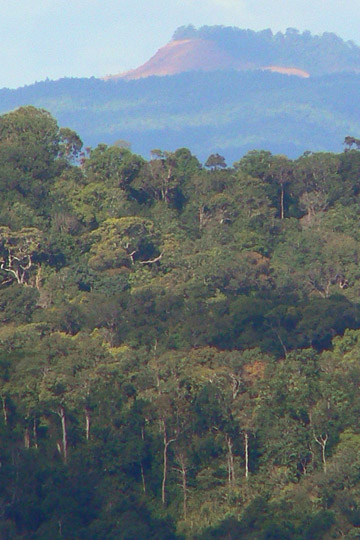 Top right is the enticing Yak Yeuk grasslands, which has never been explored by scientists or foreigners. Photo by: Greg McCann. |
Greg McCann: Yes, the Yak Yeuk Grasslands, which I mentioned earlier. Yak Yeuk (pronounced ‘yook’ and sometimes spelled as ‘Yok’) has never been explored by scientists or visited by tourists. If not for World Bank Sponsorship between 2004-2008, rangers would never have visited the place either. The only people, aside from the two rangers expeditions that involved trekking 15 days (round trip) to visit this locale, the only other people who might have seen Yak Yeuk are engineers from Indochine Ltd, the mining company that has the license to explore 90% of Virachey. They would have flown in on helicopter. No photos exist of Yak Yeuk anywhere on the net—a rarity today (you can’t even see it from Google Earth, as cloud cover is blocking the view). Two rangers have photos, but they have yet to email them to me, and I have just one shot which I took using the maximum zoom on my camera taken from the highest mountain in Veal Thom, a vantage point which affords a small glimpse of Yak Yeuk. The rangers who have been there say it is even more beautiful than Veal Thom, as this grasslands—which is almost the same size as Veal Thom—sits virtually right on top of the barrier chain near Laos. Adventure travelers need look no further!
Rangers say that it takes 5 days (one-way) of extremely tough trekking to reach Yak Yeuk, and for that reason, poachers probably don’t go there; it is simply too far and there is no guarantee of a bountiful catch. There are no trails leading there; it’s nothing but bush-whacking the entire way. When rangers visited it during the World Bank’s tenure, gaur were spotted in the open, and gibbons and douc langurs watched the rangers with curiosity from trees at the edge of the grasslands before running off.
Ching-Yum Mountain—part of the barrier chain—is another place that poachers probably have not reached. Rangers passed by it en route to Yak Yeuk from Veal Thom with World Bank support, and they observed abundant signs of carnivores. There are numerous mountains that form the border between Cambodia and Laos and they serve as the final refuge for wildlife in the area. I wouldn’t be at all surprised if there was a population of saola clinging to existence up in those mountains.
Mongabay: Are there any tigers left in the park? What do the rangers or locals have to say about their status?
Greg McCann: Rangers believe that four to five tigers still prowl the unexplored canyons of the park. Footprints were found and photographed in summer 2010, and in late 2010 two were heard roaring near the border with Vietnam—the team of six rangers was so frightened that they had to build up a large fire to try and keep the cats away. The following day the rangers destroyed a very large trap that was probably set for a tiger. The forests on the Vietnamese side of the border (Chu Mom Ray National Park) of Virachey have probably been emptied of tigers, but Laos still has a lot of suitable tiger habitat in Nam Gong (Kong) Provincial Protected Area, which sits astride Virachey to the north, and Virachey itself still has plenty of quality forest and prey species. If some camera traps were placed in these remote mountains, the results would amaze. The rangers have no doubt that tigers still exist there. I find it dumbfounding that NGOs who have never surveyed the remote areas of Virachey somehow “know” that there are no tigers in there. As we have seen with Thap Lan National Park in Thailand and with the Namdapha Tiger Reserve in India—two parks supposedly “empty” of tigers and other species, but which are, in fact, teeming with wildlife, including tigers—unless people go in and plant the camera traps in remote areas, we can never state the case conclusively. Considering Virachey’s size and the fact that there is extensive habitat directly across the border in Laos, the possibility of four to five tigers still roaming the lost canyons in the borderland is probably quite high.
Mongabay: You heard douc langurs in the park. Will you tell us about this encounter?
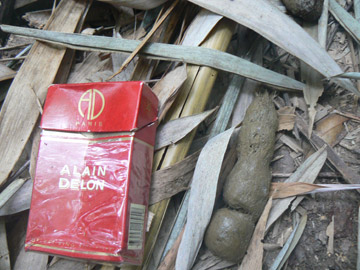 McCann’s guide believed this was clouded leopard dung. Photo by: Greg McCann. |
Greg McCann: I am pretty sure that they were gray-shanked langurs (which are known to exist in neighboring Kontum province in Vietnam, but not in Virachey—but I will get into that in a moment). We had just left the grasslands and entered the forests when we heard a loud, bizarre, cackling sound. It was unlike any primate I had ever heard before. Without a moment’s hesitation my guide said, “douc langur.” We dropped our bags and ran into the forest in the direction of the shaking branches in the canopy. For one fleeting second I saw one leap from a branch and disappear into foliage. When I check photos on Google Images of the three douc species—red, gray, and black-shanked—I determined that it had to be the gray-shanked because I do not recall seeing red in the lower legs, and I have seen this animal on two occasions inside the park. Hearing and seeing a Critically Endangered primate in the wild really made that first trip. It was exhilarating to know that one can—if they have the time, the money, and the inclination—go out and find the types of species that one normally only reads about on Web sites like WWF or FFI or Mongabay.
Could they really be gray-shanked doucs? Gray-shanked doucs are confirmed in Kontum province right up to the border with Virachey, yet the entire area was once covered in forest. Why wouldn’t animals cross over the ridge lines and spread into Cambodia? Animals don’t recognize political boundaries. What those distribution maps show is that scientists have worked in Chu Mom Ray, but not Virachey. That’s all they explain.
Mongabay: Do you think there may be species unknown to science in the park?
Greg McCann: Without a doubt. Scientists recently discovered a new species of skink in the Voen Sai Protected Forests outside of Virachey. Much more will be found in Virachey if NGOs can shake off their fears of doing work there.
CONSERVATION ISSUES
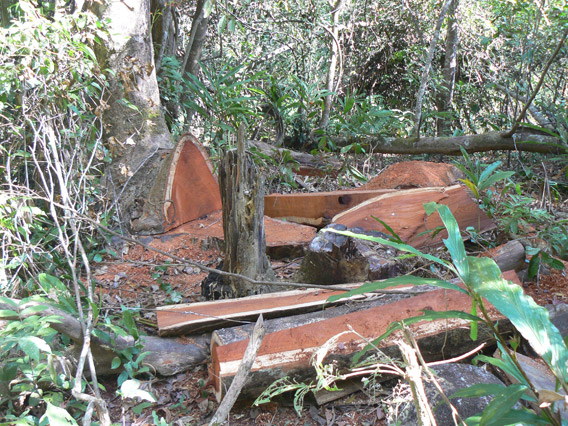
Illegal logging is a big problem in Virachey National Park, but that’s not the largest issue. Instead mining rights and rubber plantations have driven conservation groups away. Photo by: Greg McCann.
Mongabay: What are the most serious threats to the park at this time?
Greg McCann: Land sales and conversion of forests into agricultural plantations, and potential mining operations. Quite a bit of the park—possibly as much as one third of it (exact figures are impossible to come by as the government is secretive) has already been sold off to rubber developers. Most of this land is along the border with Vietnam. Indochine Ltd has been looking for gold, bauxite, and other minerals for over three years now, and they have the right to explore 90 percent of the park (only the barrier mountains themselves are off-limits to mining). However, no drilling has taken place, and from what I hear from people in Ban Lung, they haven’t found anything—at least not enough worth going to the trouble of extracting.
On top of plantations and mining, there is a proposal for a dam on the Sesan River, which would flood part of the park and submerge several highlander settlements. And of course there is rampant poaching and illegal logging. I’ve even heard that China wants to buy the entire park (I don’t know if it’s true).
Mongabay: Why did the World Bank stop funding the park in 2008? What did that decision do to the park?
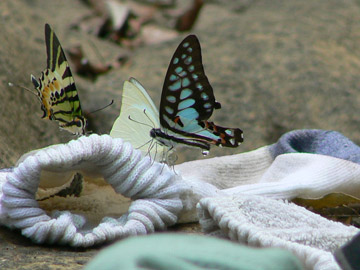 Butterflies inspect McCann’s socks on the Gan-Yu River. Photo by: Greg McCann. |
Greg McCann: They were taken by surprise by the Cambodian government’s decision to allow Indochine to explore 90 percent of the park for mining. They had just spent $5 million on setting up protection and ecotourism programs, and the Cambodian government basically threw it in their face.
When the World Bank pulled out, the park went into a free fall, and it is plunging into virtual anarchy today, with loggers and hunters seen by the dozen in and around Veal Thom and everywhere east to Vietnam. I imagine there is quite a bit of illegal activity in the western section of the park near Siem Pang as well.
The World Bank paid rangers a livable salary, but when they pulled out, ranger’s salaries dropped to about $30 per month, and many of them simply quit. The park didn’t even have a Web site when the WB left (and still doesn’t have one). Several ranger outpost stations and park offices in Voen Sai and Siem Pang districts now stand vacant and rotting.
Mongabay: A number of conservation groups have also written off Virachey due to what they perceive as the immensity of challenges in protecting the park. Do you think their fears are warranted? Is Virachey a lost cause?
Greg McCann: First, let me say that I completely understand why they feel the way they do. But, at least in recent years, I have spent more time in the park than any of them has, and I know two things:
1. The situation is even more dire than they imagine.
2. In spite of the point above, the park is still worth saving and it CAN be saved.
Conservation groups look at those maps of Virachey—the ones that break the park up into different zones for different uses—mining, rubber, and other development projects including dams—and they shudder. I do too. However, the vast majority of the development planning of the park is in the mining sector, but Indochine has been exploring for years and yet no extraction has taken place. As I said earlier, many think this is because there is simply not enough there to make it worth going in.
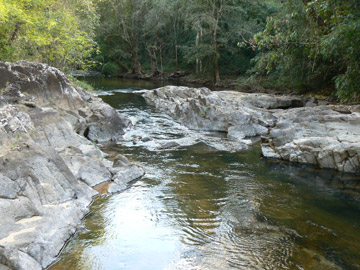 Upper Gan-Yu River, north of Veal Thom, an area where no tourists had visited before. Photo by: Greg McCann. |
Illegal logging for rosewood is rampant, happening almost everywhere but the remotest areas of the park. But even this is only selective logging of a particular (small) species of tree, and when you’re standing in Veal Thom and looking out at the jungle you don’t see any deforested patches at all: it all looks like pristine forest.
A regrettable amount of park land has been turned over to rubber development along the Vietnamese border, but even if much of that area is lost to plantations, there is still a huge area of the park (its total area is 3,325 square kilometers) that can be conserved as a major core zone. And there is the Voen Sai Protected Forest outside of Virachey that is home to many gibbons and other species. If a biological corridor can be established linking this to Virachey, then some of the land lost near Vietnam can be somewhat compensated.
Furthermore, Laos and Cambodia might be persuaded to set up an “international peace park” between Virachey and Nam Kong PPA, preserving the major watershed of the area along with wildlife and the traditional hunting grounds for indigenous people, and ecotourism possibilities are endless.
If WWF or WCS or Panthera or somebody went in there, and produced evidence of rare wildlife with camera traps and tried to work in a REDD program there along with NGO commitment, the government would, I think, at least temporarily hold off on other development plans (seeing as how they are probably not going to get anything from mining anyway and seeing as how the mountains are too steep for plantations).
Lastly, one of the main reasons why conservation groups have given up is that funding for new projects is very difficult to come by, and I sympathize with this. Many are struggling just to maintain their current commitments, and taking on a new and immensely challenging project like reviving Virachey is just too daunting for them. The fact that amazing people like Chut Wutty are murdered and groups like Global Witness are simply thrown out of the country for trying to preserve the Kingdom’s natural heritage is not encouraging either. Nonetheless I believe that a practical way to save the park is out there: REDD, Ecotourism, and possibly paying small salaries to local people to not hunt—these three things in combination with final confirmation that there are no valuable minerals in those beautiful mountains—let’s hope that Ratanakiri really isn’t the mountain of precious stones!
Mongabay: What are some of the solutions to the problems in Virachey?
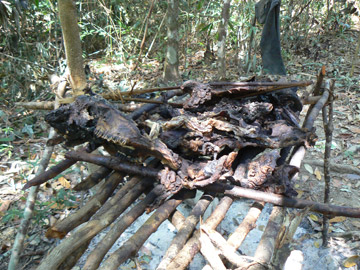 Bones of a recently poached Sambar deer. Photo by: Greg McCann. |
Greg McCann: There is no perfect solution. Local people need to see that they benefit from having a large protected area in their backyard. Unfortunately, it’s not enough to say that tigers and douc langurs and elephants are examples of the amazing natural heritage of the area and that they have intrinsic value and should be protected for their own sake. Everyone needs money now, and so people need to see how they will benefit. Ecotourism is one thing that comes to mind, but tourists need to slow down and spend some quality time in Virachey and its surrounding areas. Whenever I am in Ban Lung (provincial capital of Ratanakiri) I notice that tourists only have “a few days” before they “need” to rush off to the next destination to check off the list, such as the 4,000 Islands (Si Phan Don) waterfalls at the border of Laos and Cambodia. Why not do a more focused and intense trip? If you only have 3 or 4 weeks, then do the whole thing in one country and dig deep, get into the nitty-gritty. Spend a few nights in the highlander villages along the Sesan, get drunk on rice wine with the villagers and listen to their endless stories about mountain spirits and spirit forests, and then do the 7-day trek to Veal Thom, and if you’re really looking for adventure, then be a real trail-blazer and trek to Yak Yeuk, where you will bush-whack for five days, spend a night or two up in terra incognita, and then head back toward civilization on a makeshift bamboo raft out the O-Lai-Lai River, which is where the tiger footprint was photographed in 2010.
Mongabay: How should development needs in the provinces of Ratanakiri and Mondulkiri be balanced with conservation?
Greg McCann: If the government wants to develop the area (which they do) then they need to understand the needs of the local people before they go in and take action. The key is to find out what local people want, and then proceed from there, but that’s not at all what is happening. If the government just draws up a map (or, just as likely, if a foreign company draws up a map) of the area and says, “OK, let’s dam these rivers, sell this land and this forest and build a bridge here and a couple of roads here,” then the result isn’t development, it is exploitation and degradation. Which, in that case, makes development more like fraud in the eyes of the local people.
They want to put in a dam on the Lower Sesan River, a project that will—if it goes ahead—flood several villages. I stayed at one of those villages in February. It’s called Kompong Commune. Early one morning I walked down to the river and saw a man coming up from the embankment with five large fish flapping in a net, their wet scales glistening in the morning sun. About twenty minutes later I saw those same fish being barbecued on sticks over an open fire, where a pot of garden-grown rice was boiling and where a pile of the freshest looking vegetables I have ever seen were being chopped up. It was the healthiest-looking breakfast imaginable, and it cost that family nothing. How do you “improve” that? Sure, healthcare is lacking, but do we need to build dams and level forests to improve hygiene and healthcare? No.
ANIMSIM
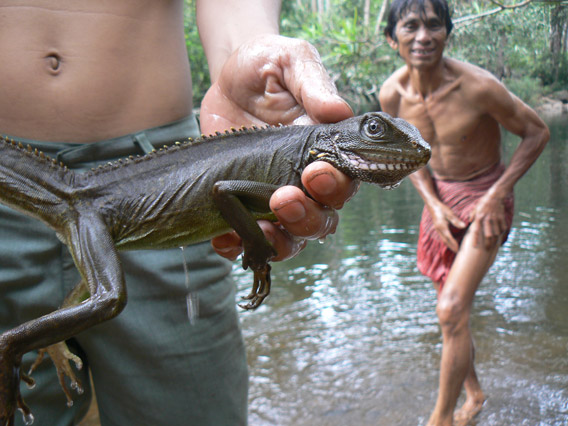
Brao villagers hold out a water dragon on the O-Pong River, Virachey. Photo by: Greg McCann.
Mongabay: Will you tell us about animism in Cambodia?
Greg McCann: The Brao, Tampuan, Kreung, Bunong and other highlander groups of northeast Cambodia believe that malevolent spirits inhabit the local ecological milieu. We are forever in danger of offending these angry, invisible celestial beings if certain etiquette is broken –if, for instance, land is cleared in a spirit forest, or if the wrong type of animal is hunted, or if signs in nature are ignored and we do things that we shouldn’t’ do. The punishment is usually injury, illness, or death. In any case, the village “magic man” or shaman is consulted, he or she communicates with the spirits to find out what is wrong, and he will tell the victim and family what is needed to remedy the situation—usually a chicken or a pig and several vases of rice wine.
Mongabay: What is the relationship between animism—the highlander’s traditional religion—and the health of the natural environment in Virachey and northeast Cambodia?
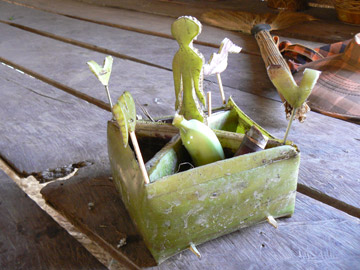 Animist drinking vessel at Piang Village on the Sesan River. Photo by: Greg McCann. |
Greg McCann: Some highlanders—usually the older ones—still believe that certain mountains—such as Haling-Halang deep inside Virachey, or Krang Mountain on Veal Thom—or certain areas of forests, are off-limits to hunting and logging. If this etiquette can be maintained, then animistic beliefs in “spirit places” can act as conservation tools. In that sense, animism is the oldest form of environmental conservation: certain places are off limits to human activity because they have been deemed sacred.
It is believed that the God of Haling-Halang is so powerful that airplanes cannot fly over it, and fires cannot burn it. Brao elders maintain that even when the Americans were dropping thousands of bombs on the area during the war that Haling-Halang never burned. Favors of Haling-Halang require a human sacrifice, and for that reason, villagers don’t seek its help. A combination of its remoteness and its sacredness has resulted in it being a relatively undisturbed massif ecosystem to date. But there are other, smaller places, such as a spirit forest outside of Kroala Village in O-Chum district outside of Ban Lung. The spirits of this little 300 square meter forest are so strong that five men recently died simply from standing in its shadow. Another man died after he tried to clear some of the woods to establish a small farm there. Villagers are now so afraid of it that even the Christians won’t go near it. The result is that barking deer, wild boar, civet cats, Giant Asian squirrels and birds find refuge there amidst a sea of cashew nut plantations.
Mongabay: How does traditional animism connect to modern environmental philosophy?
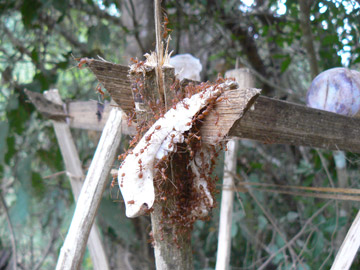 Ants crawl over a pig jawbone from a sacrificed animal. Photo by: Greg McCann. |
Greg McCann: Actually, I think that bioregionalism (my area of study) is simply a way of describing what indigenous people have always been doing. My idea (for my dissertation) is: bioregionalism is the theory, animism is the practice. Instead of sorting through a lot of dense theoretical jargon—which is common to many academic texts—students who want to come up with their own environmental philosophies should seek out indigenous societies wherever they can and see what they can learn from them, and then cross-reference those experiences with what they are reading for homework. Many good points are made by environmental philosophers, but often their ideas become a little bit abstract, divorced from the tough realities on the ground.
Animism is a belief system that was derived completely from the land and man’s relationship to it—what more fertile ground could modern environmental philosophers hope to find? Instead of paying lip service to “indigenous knowledge,” go see what they really know.
Mongabay: What’s next for you? Any trips we should know about?
Greg McCann: Plans are in the works for a January 2013 trip to Kercini Seblat National Park in Sumatra, Indonesia. Something like 150 tigers still prowl the depths of that jungle, in addition to several species of gibbon and even the orang pendak (Sumatran yeti). And like Virachey and everywhere else on, Kercini is under threat. Developers want to put several roads through the center of the park, a project that would open up previously inaccessible terrain to poachers and loggers. We live in a time when almost every natural place is under severe threat, and if you want to see some of last wild places, you had better run very, very fast. In fact, many of the wild places of Southeast Asia are already gone. Kercini is probably next up for me, but all this talk about Virachey has me thinking seriously about the mysterious Yak Yeuk Grasslands…
To contact Greg McCann: greg.mccann1@gmail.com
View Larger Map
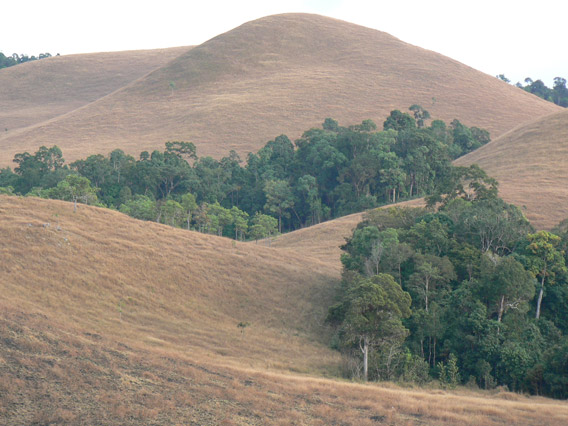
Veal Thom grasslands. Photo by: Greg McCann.
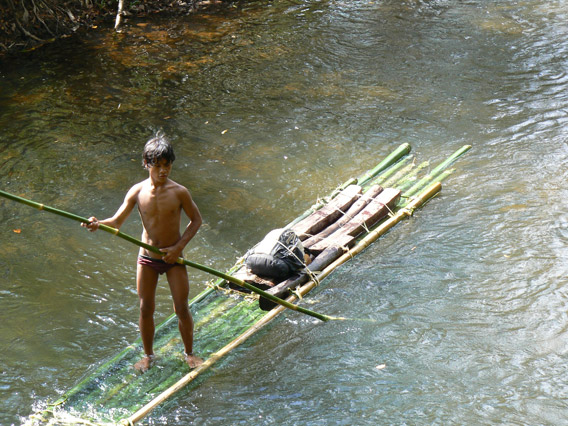
Logger on the O-Pong River. Illegal logging is often done by locals for pittance, while those organizing the trade take the bulk of the money. Photo by: Greg McCann.
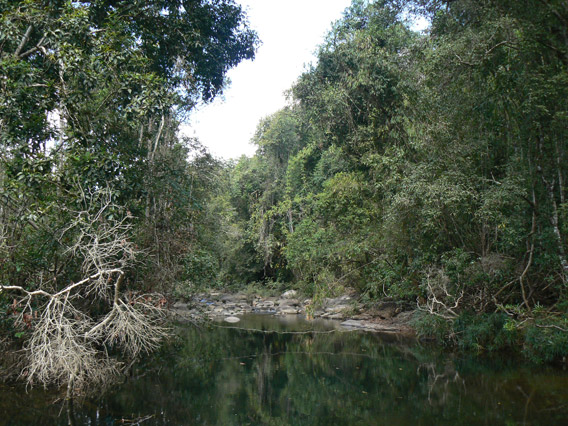
The O-Pong River. Photo by: Greg McCann.
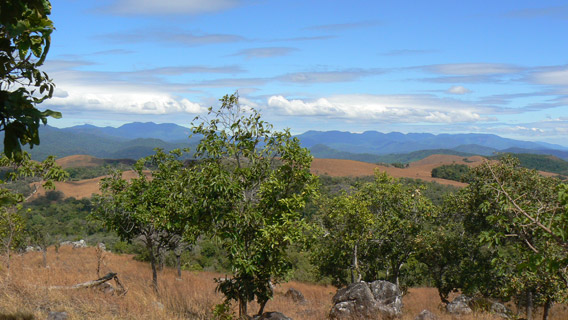
The view from Krang Mountain in Virachey National Park. Photo by: Greg McCann.
Related articles
Goodbye national parks: when ‘eternal’ protected areas come under attack
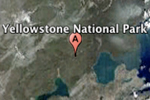
(03/17/2011) One of the major tenets behind the creation of a national park, or other protected area, is that it will not fade, but remain in essence beyond the pressures of human society, enjoyed by current generations while being preserved for future ones. The protected area is a gift, in a way, handed from one wise generation to the next. However, in the real world, dominated by short-term thinking, government protected areas are not ‘inalienable’, as Abraham Lincoln dubbed one of the first; but face being shrunk, losing legal protection, or in some cases abolished altogether. A first of its kind study, published in Conservation Letters, recorded 89 instances in 27 countries of protected areas being downsized (shrunk), downgraded (decrease in legal protections), and degazetted (abolished) since 1900. Referred to by the authors as PADDD (protected areas downgraded, downsized, or degazetted), the trend has been little studied despite its large impact on conservation efforts.
Cambodia approves rubber plantation—in national park
(03/13/2011) The Cambodian Prime Minister, Hun Sen, has approved a 9,000 hectare (22,200 acre) rubber plantation in Virachey National Park despite its status as a protected area, reports the Phnom Penh Post. The park is also listed as an ASEAN Heritage Park.
Assassinated forest activist Chut Wutty: ‘I want to see people live with freedom’
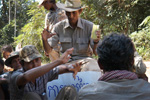
(05/02/2012) Chut Wutty, a dedicated Cambodian activist, was shot dead at an illegal logging site by military police, last Thursday. At the time Wutty was driving with two journalists, who wrote a shocking eye-witness account of his death, revealing that he was physically and verbally abused, then shot whilst trying to drive away, and left to die. His death reveals the brutal power of logging syndicates and companies, which are looting the country’s natural wealth, and employing the military to silence their opponents.
Forest activist shot dead in Cambodia allegedly over photos of illegal logging
(04/26/2012) Chut Wutty, a prominent activist against illegal logging and deforestation, has been killed in the Koh Kong province of Cambodia. Wutty was shot dead at a military police checkpoint while traveling with two journalists with The Cambodia Daily. The journalists are currently being held for questioning by the military police.
Blood rosewood: Thailand and Cambodia team up to tackle illegal logging crisis and save lives
(04/11/2012) Cambodian and Thai officials have agreed to work together to combat illegal logging of rosewood and resulting violence between Cambodian loggers and Thai rangers, reports MCOT online news. Officials with both nations met on Tuesday and spent three hours discussing the issue.
Cambodia sells off national park for city-sized pleasure resorts
(03/19/2012) The Cambodian government has handed over nearly 20 percent of Botum Sakor National Park to a Chinese real-estate firm building a massive casino and resorts in the middle of pristine rainforest, reports Reuters. The city-sized resorts, costing $3.8 billion, will include a 64 kilometers highway, an airport, hotels, and golf courses. Botum Sakur is home to a number of endangered species including the pileated gibbon (Hylobates pileatus) and Asian elephant (Elephas maximus).
Photos: Cambodians rally as ‘Avatars’ to save one of the region’s last great rainforests
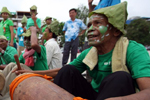
(05/31/2011) Two hundred Cambodians rallied in Phnom Penh last week to protest the widespread destruction of one of Southeast Asia’s last intact lowland rainforests, known as Prey Lang. In an effort to gain wider media attention, protestors donned dress and make-up inspired by the James Cameron film, Avatar, which depicts the destruction of a forest and its inhabitants on an alien world. The idea worked as the rally received international attention from Reuters, CNN (i-report), MSNBC, and NPR, among other media outlets.
Cambodia’s wildlife pioneer: saving species and places in Southeast Asia’s last forest
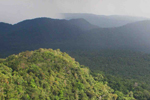
(05/11/2011) Suwanna Gauntlett has dedicated her life to protecting rainforests and wildlife in some of the world’s most hostile and rugged environments and has set the trend of a new generation of direct action conservationists. She has designed, implemented, and supported bold, front-line conservation programs to save endangered wildlife populations from the brink of extinction, including saving the Amur Tiger (also known as the Siberian Tiger) from extinction in the 1990s in the Russian Far East, when only about 80 individuals remained and reversing the drastic decline of Olive Ridley sea turtles along the coast of Orissa, India in the 1990s, when annual nestings had declined from 600,000 to a mere 8,130. When she first arrived in Cambodia in the late 1990s, its forests were silent. ‘You couldn’t hear any birds, you couldn’t hear any wildlife and you could hardly see any signs of wildlife because of the destruction,’ Gauntlett said. Wildlife was being sold everywhere, in restaurants, on the street, and even her local beauty parlor had a bear.
(04/11/2011) In a surprise move, the Cambodian Prime Minister, Sandech Hun Sen, has cancelled a titanium strip mine project in one of Southeast Asia’s last great intact forest ecosystems, the Cardamom Mountains. According to a press release sent out by the Cambodian government the mine was canceled due to “concerns of the impact on the environment, biodiversity and local livelihoods” of villagers. The mine, which was planned to sit directly in the migration route for the largest population of Asian elephants in Cambodia, had been largely opposed by locals in the region who spent years developing eco-tourism in the region.
Cambodians prevented from protesting destruction of their forest
(03/10/2011) Cambodian villagers fighting to save their forest from rubber companies have been rebuked by the local government. Two days in a row local authorities prevented some 400 Cambodian villagers from protesting at the offices of the Vietnam-based CRCK Company, which the villagers contend are destroying their livelihoods by bulldozing large swaths of primary forests. Authorities said they feared the villagers would have grown violent while protesting.
From Cambodia to California: the world’s top 10 most threatened forests

(02/02/2011) Growing populations, expanding agriculture, commodities such as palm oil and paper, logging, urban sprawl, mining, and other human impacts have pushed many of the world’s great forests to the brink. Yet scientists, environmentalists, and even some policymakers increasingly warn that forests are worth more standing than felled. They argue that by safeguarding vulnerable biodiversity, sequestering carbon, controlling erosion, and providing fresh water, forests provide services to humanity, not to mention the unquantifiable importance of having wild places in an increasingly human-modified world. Still, the decline of the world’s forests continues: the FAO estimating that around 10 million hectares of tropical forest are lost every year. Of course, some of these forests are more imperiled than others, and a new analysis by Conservation International (CI) has catalogued the world’s 10 most threatened forests.